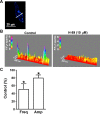Constitutive PKA activity is essential for maintaining the excitability and contractility in guinea pig urinary bladder smooth muscle: role of the BK channel
- PMID: 25318105
- PMCID: PMC4269660
- DOI: 10.1152/ajpcell.00167.2014
Constitutive PKA activity is essential for maintaining the excitability and contractility in guinea pig urinary bladder smooth muscle: role of the BK channel
Abstract
The elevation of protein kinase A (PKA) activity activates the large-conductance voltage- and Ca(2+)-activated K(+) (BK) channels in urinary bladder smooth muscle (UBSM) cells and consequently attenuates spontaneous phasic contractions of UBSM. However, the role of constitutive PKA activity in UBSM function has not been studied. Here, we tested the hypothesis that constitutive PKA activity is essential for controlling the excitability and contractility of UBSM. We used patch clamp electrophysiology, line-scanning confocal and ratiometric fluorescence microscopy on freshly isolated guinea pig UBSM cells, and isometric tension recordings on freshly isolated UBSM strips. Pharmacological inhibition of the constitutive PKA activity with H-89 or PKI 14-22 significantly reduced the frequency and amplitude of spontaneous transient BK channel currents (TBKCs) in UBSM cells. Confocal and ratiometric fluorescence microscopy studies revealed that inhibition of constitutive PKA activity with H-89 reduced the frequency and amplitude of the localized Ca(2+) sparks but increased global Ca(2+) levels and the magnitude of Ca(2+) oscillations in UBSM cells. H-89 abolished the spontaneous transient membrane hyperpolarizations and depolarized the membrane potential in UBSM cells. Inhibition of PKA with H-89 or KT-5720 also increased the amplitude and muscle force of UBSM spontaneous phasic contractions. This study reveals the novel concept that constitutive PKA activity is essential for controlling localized Ca(2+) signals generated by intracellular Ca(2+) stores and cytosolic Ca(2+) levels. Furthermore, constitutive PKA activity is critical for mediating the spontaneous TBKCs in UBSM cells, where it plays a key role in regulating spontaneous phasic contractions in UBSM.
Keywords: Ca2+ sparks; H-89; PKI 14–22; large-conductance voltage- and Ca2+-activated K+ channels; protein kinase A.
Copyright © 2014 the American Physiological Society.
Figures








Similar articles
-
Urinary bladder smooth muscle ion channels: expression, function, and regulation in health and disease.Am J Physiol Renal Physiol. 2020 Aug 1;319(2):F257-F283. doi: 10.1152/ajprenal.00048.2020. Epub 2020 Jul 6. Am J Physiol Renal Physiol. 2020. PMID: 32628539 Free PMC article. Review.
-
BK channel-mediated relaxation of urinary bladder smooth muscle: a novel paradigm for phosphodiesterase type 4 regulation of bladder function.J Pharmacol Exp Ther. 2014 Apr;349(1):56-65. doi: 10.1124/jpet.113.210708. Epub 2014 Jan 23. J Pharmacol Exp Ther. 2014. PMID: 24459245 Free PMC article.
-
Large-conductance voltage- and Ca2+-activated K+ channel regulation by protein kinase C in guinea pig urinary bladder smooth muscle.Am J Physiol Cell Physiol. 2014 Mar 1;306(5):C460-70. doi: 10.1152/ajpcell.00325.2013. Epub 2013 Dec 18. Am J Physiol Cell Physiol. 2014. PMID: 24352333 Free PMC article.
-
Prostaglandin E2 excitatory effects on guinea pig urinary bladder smooth muscle: a novel regulatory mechanism mediated by large-conductance voltage- and Ca2+-activated K+ channels.Eur J Pharmacol. 2014 Sep 5;738:179-85. doi: 10.1016/j.ejphar.2014.05.042. Epub 2014 Jun 2. Eur J Pharmacol. 2014. PMID: 24886877 Free PMC article.
-
Central role of the BK channel in urinary bladder smooth muscle physiology and pathophysiology.Am J Physiol Regul Integr Comp Physiol. 2014 Sep 15;307(6):R571-84. doi: 10.1152/ajpregu.00142.2014. Epub 2014 Jul 2. Am J Physiol Regul Integr Comp Physiol. 2014. PMID: 24990859 Free PMC article. Review.
Cited by
-
Urinary bladder smooth muscle ion channels: expression, function, and regulation in health and disease.Am J Physiol Renal Physiol. 2020 Aug 1;319(2):F257-F283. doi: 10.1152/ajprenal.00048.2020. Epub 2020 Jul 6. Am J Physiol Renal Physiol. 2020. PMID: 32628539 Free PMC article. Review.
-
Attenuated BK channel function promotes overactive bladder in a rat model of obesity.Aging (Albany NY). 2019 Aug 21;11(16):6199-6216. doi: 10.18632/aging.102182. Epub 2019 Aug 21. Aging (Albany NY). 2019. PMID: 31480021 Free PMC article.
-
BK channel regulation by phosphodiesterase type 1: a novel signaling pathway controlling human detrusor smooth muscle function.Am J Physiol Renal Physiol. 2016 May 15;310(10):F994-9. doi: 10.1152/ajprenal.00452.2015. Epub 2016 Feb 24. Am J Physiol Renal Physiol. 2016. PMID: 26911851 Free PMC article.
-
Expression and function of the small-conductance Ca2+-activated K+ channel is decreased in urinary bladder smooth muscle cells from female guinea pig with partial bladder outlet obstruction.Int Urol Nephrol. 2017 Jul;49(7):1147-1155. doi: 10.1007/s11255-017-1592-0. Epub 2017 Apr 17. Int Urol Nephrol. 2017. PMID: 28417339
-
Partial bladder outlet obstruction is associated with decreased expression and function of the small-conductance Ca2+-activated K+ channel in guinea pig detrusor smooth muscle.Int Urol Nephrol. 2017 Jan;49(1):17-26. doi: 10.1007/s11255-016-1455-0. Epub 2016 Nov 14. Int Urol Nephrol. 2017. PMID: 27844406
References
-
- Andersson KE, Arner A. Urinary bladder contraction and relaxation: physiology and pathophysiology. Physiol Rev 84: 935–986, 2004. - PubMed
-
- Beca S, Ahmad F, Shen W, Liu J, Makary S, Polidovitch N, Sun J, Hockman S, Chung YW, Movsesian M, Murphy E, Manganiello V, Backx PH. Phosphodiesterase type 3A regulates basal myocardial contractility through interacting with sarcoplasmic reticulum calcium ATPase type 2a signaling complexes in mouse heart. Circ Res 112: 289–297, 2013. - PMC - PubMed
-
- Borisova L, Shmygol A, Wray S, Burdyga T. Evidence that a Ca2+ sparks/STOCs coupling mechanism is responsible for the inhibitory effect of caffeine on electro-mechanical coupling in guinea pig ureteric smooth muscle. Cell Calcium 42: 303–311, 2007. - PubMed
-
- Brown SM, Bentcheva-Petkova LM, Liu L, Hristov KL, Chen M, Kellett WF, Meredith AL, Aldrich RW, Nelson MT, Petkov GV. β-Adrenergic relaxation of mouse urinary bladder smooth muscle in the absence of large-conductance Ca2+-activated K+ channel. Am J Physiol Renal Physiol 295: F1149–F1157, 2008. - PMC - PubMed
Publication types
MeSH terms
Substances
Grants and funding
LinkOut - more resources
Full Text Sources
Other Literature Sources
Miscellaneous

